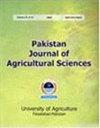Development of new two methods based on low-cost sensors for determination of calcium carbonate contents of soils
IF 0.6
4区 农林科学
Q3 AGRICULTURE, MULTIDISCIPLINARY
引用次数: 0
Abstract
The chemical analysis of CaCO3 contents of soils provide information about not only efficiency of soil for supplying plant with nutrients but also identification of factors affecting this efficiency in the soil. The aim of the current experiment was to develop new methods based on sensors and compare with conventional Scheibler method. The CO2 liberated by the action of HCl on CaCO3 content of the soil in a reaction bottle and an accumulation chamber was determined by pressure sensor and CO2 sensor, respectively. The CaCO3 contents of soils were estimated using the regression equation of standard curves. The CaCO3 contents of soils obtained using Scheibler calcimetric, pressure and CO2 sensor methods ranged from 0.20 to 54.74%, 0.25 to 54.10% and 0.55 to 53.05%, respectively. On the basis of linearity of calibration curve and high correlation with Scheibler calcimetric method it can be said that developed pressure and CO2 sensor methods appears to be very useful for quantification of CaCO3 contents of soils. The pressure sensor has provided the opportunity in developing a simple and handy device with an affordable cost to measure CaCO3 contents of soils as accurately as Scheibler calcimeter when compared with CO2 sensor method. Even if there is a good relationship between Scheibler calcimetric method and CO2 sensor method the cost of CO2 sensor method may limit the use in determination of CaCO3 contents of soils. However, CO2 sensor method can be used to monitor CO2 evolved in biochemical process such as respiration and fermentation基于低成本传感器的两种新的土壤碳酸钙含量测定方法的发展
土壤中CaCO3含量的化学分析不仅提供了有关土壤向植物提供养分的效率的信息,而且还确定了影响土壤中这种效率的因素。当前实验的目的是开发基于传感器的新方法,并与传统的Scheibler方法进行比较。通过压力传感器和CO2传感器分别测定HCl对反应瓶和积聚室中土壤的CaCO3含量的作用释放的CO2。采用标准曲线回归方程估算了土壤中CaCO3的含量。使用Scheibler钙化法、压力法和CO2传感器法获得的土壤CaCO3含量分别为0.20至54.74%、0.25至54.10%和0.55至53.05%。基于校准曲线的线性和与Scheibler钙化法的高度相关性,可以说,开发的压力和CO2传感器方法似乎对土壤CaCO3含量的定量非常有用。与CO2传感器方法相比,压力传感器为开发一种简单方便、成本合理的设备提供了机会,可以像Scheibler钙化仪一样准确地测量土壤中的CaCO3含量。即使Scheibler钙化法和CO2传感器法之间存在良好的关系,CO2传感器法的成本也可能限制在土壤CaCO3含量测定中的使用。然而,CO2传感器方法可以用于监测呼吸和发酵等生化过程中产生的CO2
本文章由计算机程序翻译,如有差异,请以英文原文为准。
求助全文
约1分钟内获得全文
求助全文
来源期刊

Pakistan Journal of Agricultural Sciences
AGRICULTURE, MULTIDISCIPLINARY-
CiteScore
1.80
自引率
25.00%
发文量
18
审稿时长
6-12 weeks
期刊介绍:
Pakistan Journal of Agricultural Sciences is published in English four times a year. The journal publishes original articles on all aspects of agriculture and allied fields.
 求助内容:
求助内容: 应助结果提醒方式:
应助结果提醒方式:


